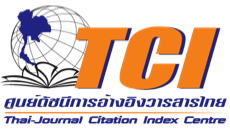การเปรียบเทียบการจัดการเรียนรู้ที่แตกต่างกัน ที่มีต่อคุณลักษณะกรอบคิดติดยึดเติบโต ของนักเรียนชั้นประถมศึกษาปีที่ 6 (A Comparison Difference Instruction on Growth Mindset in the Elementary School of Sixth Grade Students)
คำสำคัญ:
การสอนแบบกรอบคิดติดยึดเติบโต, การสอนแบบปกติ, การจัดการเรียนรู้บทคัดย่อ
วิจัยนี้มีวัตถุประสงค์เพื่อ 1) เปรียบเทียบคุณลักษณะกรอบคิดติดยึดเติบโต ของนักเรียนที่เรียนแบบกรอบคิดติดยึดเติบโต ก่อนเรียนกับหลังเรียน 2) เปรียบเทียบคุณลักษณะกรอบคิดติดยึดเติบโต ที่เรียนด้วยการเรียนแบบกรอบคิดติดยึดเติบโต กับการเรียนแบบปกติ กลุ่มตัวอย่างคือ นักเรียนชั้นประถมศึกษาปีที่ 6 โรงเรียนมะม่วง ภาคเรียนที่ 2 ปีการศึกษา 2561 จำนวน 64 คน แบ่งเป็น 2 ห้องเรียน ห้องเรียนละ 32 คน โดยการสุ่มแบบแบ่งกลุ่ม ได้จำนวน 2 ห้อง แล้วทำการสุ่มอย่างง่ายอีกครั้งหนึ่งด้วยการจับฉลาก ได้ห้องเรียนกลุ่มทดลองและกลุ่มควบคุม กลุ่มทดลองสอนแบบกรอบคิดติดยึดเติบโต และกลุ่มควบคุมสอนแบบปกติ เครื่องมือการวิจัยคือ 1) แผนการสอนกรอบคิดติดยึดเติบโต จำนวน 16 แผน 2) แผนการสอนแบบปกติ จำนวน 16 แผน 3) แบบวัดคุณลักษณะกรอบคิดติดยึดเติบโต และมีค่าดัชนีความสอดคล้อง 0.87 สถิติที่ใช้ในงานวิจัย ค่าเฉลี่ย ส่วนเบี่ยงเบนมาตรฐาน เปอร์เซ็นต์ เปรียบเทียบคุณลักษณะของกรอบคิดติดยึดเติบโต ก่อนเรียนและหลังเรียนของนักเรียนกลุ่มทดลองโดย t-test (Dependence Sample) และเปรียบเทียบกรอบคิดติดยึดเติบโต หลังการทดลองระว่างกลุ่มทดลอง กับกลุ่มควบคุม โดยวิเคราะห์ความแปรปรวนร่วม (One Way ANCOVA) ผลการวิจัย พบว่า 1) นักเรียนที่ได้รับการสอนแบบกรอบคิดติดยึดเติบโต มีคุณลักษณะกรอบคิดติดยึดเติบโต หลังเรียนสูงกว่าก่อนเรียน อย่างมีนัยสำคัญทางสถิติที่ระดับ .05 2) นักเรียนที่ได้รับการสอนแบบกรอบคิดติดยึดเติบโต มีคุณลักษณะกรอบคิดติดยึดเติบโต หลังเรียนสูงกว่านักเรียนที่ได้รับการสอนแบบปกติ อย่างมีนัยสำคัญทางสถิติที่ระดับ .05
เอกสารอ้างอิง
achievement across the junior high school transition: A longitudinal study and an
intervention. Child Development, 78(1), 246–263.
Cury, F., Fonseca, D. D., Zahn, I., & Elloit, A. (2008). Implicit theories and IQ test performance:
A sequential mediational analysis. Journal of Experimental Social Psychology, 44(3),
783-791.
Dweck, C. S. (2010). Mindset: The new psychology of success. New York: Random House.
Dweck, C. S.. (2012). Mindset: How you can fulfill your potential. n.p. Constable & Robinson Limited.
Dweck, C. S. (2006). Mindset: The new psychology of success. New York: Random House.
Marzano, R. J. (1996). Eight questions about implementing standards-based education. Practical
Assessment, Research & Evaluation, 5(6),1-5.
Ministry of Education. (2009). The Core Curriculum of Basic Education, Buddhist Era. 2008Bangkok: Shipping and Package Organization. (In Thai)
Murphy, M. C., & Dweck, C. S. (2015). Mindsets shape consumer behavior, Journal of Consumer Psychology, 20(15): 42-53.
Office of the Basic Education Commission and the Center for Educational Psychology Yuwasathirakhun Foundation. (2016) Developing a Growth Mindset. Bangkok: PSU. (In Thai)
Office of Academic Affairs and Educational Standards Office of the Basic Education Commission. (2016). Guidelines for curriculum management. According to the Basic Education Core Curriculum 2008 (2nd edition). Bangkok: Agricultural Cooperatives Association of Thailand. (In Thai)
Ricci, M. C. (2013). Mindset in the classroom building a culture of success and student achievement in school. n.p. Prufrock.
Suriyachanhom, T. (2018). Development of a model for enhancing the Growth Mindset for
students in the teaching profession program. (Doctor of Philosophy Thesis). Mahasarakham University. (In Thai)
Susaraj, P. (2013). The development of thinking. (5th printing). Bangkok: 9119 Printing Techniques. (In Thai)
Tangkittiphaporn, J. (2014). General Psychology. Bangkok: Chulalongkorn Publishing House
university. (In Thai)





